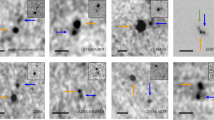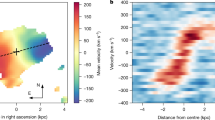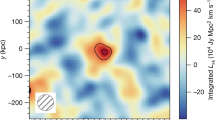Abstract
The earliest galaxies are thought to have emerged during the first billion years of cosmic history, initiating the ionization of the neutral hydrogen that pervaded the Universe at this time. Studying this ‘epoch of reionization’ involves looking for the spectral signatures of ancient galaxies that are, owing to the expansion of the Universe, now very distant from Earth and therefore exhibit large redshifts. However, finding these spectral fingerprints is challenging. One spectral characteristic of ancient and distant galaxies is strong hydrogen-emission lines (known as Lyman-α lines), but the neutral intergalactic medium that was present early in the epoch of reionization scatters such Lyman-α photons. Another potential spectral identifier is the line at wavelength 157.4 micrometres of the singly ionized state of carbon (the [C ii] λ = 157.74 μm line), which signifies cooling gas and is expected to have been bright in the early Universe. However, so far Lyman-α-emitting galaxies from the epoch of reionization have demonstrated much fainter [C ii] luminosities than would be expected from local scaling relations1,2,3,4,5, and searches for the [C ii] line in sources without Lyman-α emission but with photometric redshifts greater than 6 (corresponding to the first billion years of the Universe) have been unsuccessful. Here we identify [C ii] λ = 157.74 μm emission from two sources that we selected as high-redshift candidates on the basis of near-infrared photometry; we confirm that these sources are two galaxies at redshifts of z = 6.8540 ± 0.0003 and z = 6.8076 ± 0.0002. Notably, the luminosity of the [C ii] line from these galaxies is higher than that found previously in star-forming galaxies with redshifts greater than 6.5. The luminous and extended [C ii] lines reveal clear velocity gradients that, if interpreted as rotation, would indicate that these galaxies have similar dynamic properties to the turbulent yet rotation-dominated disks that have been observed in Hα-emitting galaxies two billion years later, at ‘cosmic noon’.
This is a preview of subscription content, access via your institution
Access options
Access Nature and 54 other Nature Portfolio journals
Get Nature+, our best-value online-access subscription
$29.99 / 30 days
cancel any time
Subscribe to this journal
Receive 51 print issues and online access
$199.00 per year
only $3.90 per issue
Buy this article
- Purchase on Springer Link
- Instant access to full article PDF
Prices may be subject to local taxes which are calculated during checkout




Similar content being viewed by others
References
Ouchi, M. et al. An intensely star-forming galaxy at z ∼ 7 with low dust and metal content revealed by deep ALMA and HST observations. Astrophys. J. 778, 102 (2013)
Ota, K. et al. ALMA observation of 158 [C ii] line and dust continuum of a z = 7 normally star-forming galaxy in the epoch of reionization. Astrophys. J. 792, 34 (2014)
Maiolino, R. et al. The assembly of ‘normal’ galaxies at z ∼ 7 probed by ALMA. Mon. Not. R. Astron. Soc. 452, 54–68 (2015)
Knudsen, K. K. et al. [C II] emission in z ∼ 6 strongly lensed, star-forming galaxies. Mon. Not. R. Astron. Soc. 462, L6–L10 (2016)
Pentericci, L. et al. Tracing the reionization epoch with ALMA: [C II] emission in z ~ 7 galaxies. Astrophys. J. 829, L11 (2016)
Stark, D. P. Galaxies in the first billion years after the Big Bang. Annu. Rev. Astron. Astrophys. 54, 761–803 (2016)
Smit, R. et al. High-precision photometric redshifts from Spitzer/IRAC: extreme [3.6]–[4.5] colors identify galaxies in the redshift range z ∼ 6.6−6.9. Astrophys. J. 801, 122 (2015)
Smit, R. et al. Evidence for ubiquitous high-equivalent-width nebular emission in z ∼ 7 galaxies: toward a clean measurement of the specific star-formation rate using a sample of bright, magnified galaxies. Astrophys. J. 784, 58 (2014)
Riechers, D. A. et al. A dust-obscured massive maximum-starburst galaxy at a redshift of 6.34. Nature 496, 329–333 (2013)
Strandet, M. L. et al. ISM properties of a massive dusty star-forming galaxy discovered at z ∼ 7. Astrophys. J. 842, L15 (2017)
Aravena, M. et al. The ALMA spectroscopic survey in the Hubble ultra deep field: search for [CII] line and dust emission in 6 < z < 8 galaxies. Astrophys. J. 833, 71 (2016)
Leroy, A. K. et al. Estimating the star formation rate at 1 kpc scales in nearby galaxies. Astron. J. 144, 3 (2012)
Meurer, G. R., Heckman, T. M. & Calzetti, D. Dust absorption and the ultraviolet luminosity density at z ∼ 3 as calibrated by local starburst galaxies. Astrophys. J. 521, 64–80 (1999)
Prevot, M. L., Lequeux, J., Prevot, L., Maurice, E. & Rocca-Volmerange, B. The typical interstellar extinction in the Small Magellanic Cloud. Astron. Astrophys. 132, 389–392 (1984)
De Looze, I. et al. The applicability of far-infrared fine-structure lines as star formation rate tracers over wide ranges of metallicities and galaxy types. Astron. Astrophys. 568, A62 (2014)
Capak, P. L. et al. Galaxies at redshifts 5 to 6 with systematically low dust content and high [C ii] emission. Nature 522, 455–458 (2015)
Willott, C. J., Carilli, C. L., Wagg, J. & Wang, R. Star formation and the interstellar medium in z > 6 UV-luminous Lyman-break galaxies. Astrophys. J. 807, 180 (2015)
Smith, J. D. T. et al. The spatially resolved [CII] cooling line deficit in galaxies. Astrophys. J. 834, 5 (2017)
Vallini, L., Ferrara, A., Pallottini, A. & Gallerani, S. Molecular cloud photoevaporation and far-infrared line emission. Mon. Not. R. Astron. Soc. 467, 1300–1312 (2017)
Herrera-Camus, R. et al. [C II] 158 μm emission as a star formation tracer. Astrophys. J. 800, 1 (2015)
Stark, D. P. et al. Lyα and C III] emission in z = 7–9 galaxies: accelerated reionization around luminous star-forming systems? Mon. Not. R. Astron. Soc. 464, 469–479 (2017)
Bowler, R. A. A., Dunlop, J. S., McLure, R. J. & McLeod, D. J. Unveiling the nature of bright z ∼ 7 galaxies with the Hubble Space Telescope. Mon. Not. R. Astron. Soc. 466, 3612–3635 (2017)
Riechers, D. A. et al. ALMA imaging of gas and dust in a galaxy protocluster at redshift 5.3: [C II] emission in “typical” galaxies and dusty starbursts ∼1 billion years after the Big Bang. Astrophys. J. 796, 84 (2014)
Pavesi, R. et al. ALMA reveals weak [N ii] emission in “typical” galaxies and intense starbursts at z = 5–6. Astrophys. J. 832, 151 (2016)
Förster Schreiber, N. M. et al. The SINS survey: SINFONI integral field spectroscopy of z ∼ 2 star-forming galaxies. Astrophys. J. 706, 1364–1428 (2009)
Gnerucci, A. et al. Dynamical properties of AMAZE and LSD galaxies from gas kinematics and the Tully–Fisher relation at z ∼ 3. Astron. Astrophys. 528, A88 (2011)
Fiacconi, D. et al. Young and turbulent: the early life of massive galaxy progenitors. Mon. Not. R. Astron. Soc. 467, 4080–4100 (2017)
Watson, D. et al. A dusty, normal galaxy in the epoch of reionization. Nature 519, 327–330 (2015)
Schaerer, D. et al. New constraints on dust emission and UV attenuation of z = 6.5–7.5 galaxies from millimeter observations. Astron. Astrophys. 574, A19 (2015)
Laporte, N. et al. Dust in the reionization era: ALMA observations of a z = 8.38 gravitationally lensed galaxy. Astrophys. J. 837, L21 (2017)
Chabrier, G. Galactic stellar and substellar initial mass function. Publ. Astron. Soc. Pac. 115, 763–795 (2003)
Oke, J. B. & Gunn, J. E. Secondary standard stars for absolute spectrophotometry. Astrophys. J. 266, 713–717 (1983)
McMullin, J. P., Waters, B., Schiebel, D., Young, W. & Golap, K. CASA architecture and applications. In Astronomical Data Analysis Software and Systems XVI (eds Shaw, R. A., Hill, F. & Bell, D. J.) 127–130 (Astron. Soc. Pac. Conf. Ser. Vol. 376, 2007)
Dunlop, J. S. et al. A deep ALMA image of the Hubble ultra deep field. Mon. Not. R. Astron. Soc. 466, 861–883 (2017)
Narayanan, D. et al. The IRX-beta dust attenuation relation in cosmological galaxy formation simulations. Preprint at https://arxiv.org/abs/1705.05858 (2017)
Koprowski, M. P. et al. A resolved map of the infrared excess in a Lyman break galaxy at z = 3. Astrophys. J. 828, L21 (2016)
Kennicutt, R. C. & Evans, N. J. Star formation in the Milky Way and nearby galaxies. Annu. Rev. Astron. Astrophys. 50, 531–608 (2012)
Brammer, G. B. et al. 3D-HST: a wide-field grism spectroscopic survey with the Hubble space telescope. Astrophys. J. Suppl. Ser. 200, 13 (2012)
Stark, D. P. et al. Keck spectroscopy of 3 < z < 7 faint Lyman break galaxies: the importance of nebular emission in understanding the specific star formation rate and stellar mass density. Astrophys. J. 763, 129 (2013)
Smit, R. et al. Inferred Hα flux as a star formation rate indicator at z ∼4–5: implications for dust properties, burstiness, and the z = 4–8 star formation rate functions. Astrophys. J. 833, 254 (2016)
da Cunha, E., Charlot, S. & Elbaz, D. A simple model to interpret the ultraviolet, optical and infrared emission from galaxies. Mon. Not. R. Astron. Soc. 388, 1595–1617 (2008)
da Cunha, E. et al. An ALMA survey of sub-millimeter galaxies in the extended Chandra deep field south: physical properties derived from ultraviolet-to-radio modeling. Astrophys. J. 806, 110 (2015)
Feng, Y. et al. The formation of Milky Way-mass disk galaxies in the first 500 million years of a cold dark matter universe. Astrophys. J. 808, L17 (2015)
Katz, H., Kimm, T., Sijacki, D. & Haehnelt, M. G. Interpreting ALMA observations of the ISM during the epoch of reionization. Mon. Not. R. Astron. Soc. 468, 4831–4861 (2017)
Pallottini, A. et al. Zooming on the internal structure of z ∼6 galaxies. Mon. Not. R. Astron. Soc. 465, 2540–2558 (2017)
Stott, J. P. et al. The KMOS redshift one spectroscopic survey (KROSS): dynamical properties, gas and dark matter fractions of typical z ∼1 star-forming galaxies. Mon. Not. R. Astron. Soc. 457, 1888–1904 (2016)
Wuyts, S. et al. KMOS3D: dynamical constraints on the mass budget in early star-forming disks. Astrophys. J. 831, 149 (2016)
Mason, C. A. et al. First results from the KMOS lens-amplified spectroscopic survey (KLASS): kinematics of lensed galaxies at cosmic noon. Astrophys. J. 838, 14 (2017)
Carniani, S. et al. Strongly star-forming rotating disks in a complex merging system at z = 4.7 as revealed by ALMA. Astron. Astrophys. 559, A29 (2013)
Williams, R. J. et al. Constraining the nature of two Lyα emitters detected by ALMA at z = 4.7. Mon. Not. R. Astron. Soc. 439, 2096–2101 (2014)
Burkert, A. et al. High-redshift star-forming galaxies: angular momentum and baryon fraction, turbulent pressure effects, and the origin of turbulence. Astrophys. J. 725, 2324–2332 (2010)
Burkert, A. et al. The angular momentum distribution and baryon content of star-forming galaxies at z ∼1–3. Astrophys. J. 826, 214 (2016)
Newman, S. F. et al. The SINS/zC-SINF survey of z ∼2 galaxy kinematics: the nature of dispersion-dominated galaxies. Astrophys. J. 767, 104 (2013)
Acknowledgements
This paper makes use of the following ALMA data: ADS/JAO.ALMA#2015.1.01111.S (http://almascience.org/aq?project_code=2015.1.01111.S). ALMA is a partnership of the European Southern Observatory (ESO, UK), the National Science Foundation (NSF, USA) and the National Institute of Natural Sciences (NINS, Japan), together with the National Research Council (NRC, Canada), the National Security Council (NSC) and Academia Sinica Institute of Astronomy and Astrophysics (ASIAA, Taiwan), and the Korea Astronomy and Space Science Institute (KASI, South Korea), in cooperation with Chile. The Joint ALMA Observatory is operated by ESO, Associated Universities Inc. (AUI)/National Radio Astronomy Observatory (NRAO), and the National Astronomical Observatory of Japan (NAOJ). This work is part of a Rubicon programme, ‘A multi-wavelength view of the first galaxies’, with project number 680-50-1518, which is financed by the Netherlands Organisation for Scientific Research (NWO). R.M. and S.C. acknowledge ERC Advanced Grant 695671 ‘QUENCH’ and support by the Science and Technology Facilities Council (STFC).
Author information
Authors and Affiliations
Contributions
R.S. performed the data reduction and nearly all data analysis for this work. S.C. carried out the modelling of a thin disk to the velocity fields. R.S. led the telescope proposal to obtain the dataset, with a number of key ideas contributed by R.J.B. R.S. was responsible for making all of the figures and writing most of the text. R.J.B., S.C., P.A.O., I.L., G.D.I., P.v.d.W., L.D.B., V.G., J.A.H., B.W.H., R.M. and W.Z. contributed feedback on the various versions of this manuscript and on the telescope proposal.
Corresponding author
Ethics declarations
Competing interests
The authors declare no competing financial interests.
Additional information
Publisher's note: Springer Nature remains neutral with regard to jurisdictional claims in published maps and institutional affiliations.
Extended data figures and tables
Extended Data Figure 1 Models of the velocity fields of COS-3018555981 and COS-2987030247, using a disk model.
a–h, Model fits to the velocity gradients in COS-3018555981 (a–d) and COS-2987030247 (e–h), assuming that the gas is rotating in an exponential, circularly symmetric thin disk. a, e, High-resolution disk model before convolution with the beam; b, f, disk model at the resolution of our observations; c, g, our velocity maps, as shown in Fig. 3; d, h, residuals after subtraction of the model. Although the disk model is not a unique solution for these velocity fields, our galaxies are well described by regular rotation.
Rights and permissions
About this article
Cite this article
Smit, R., Bouwens, R., Carniani, S. et al. Rotation in [C ii]-emitting gas in two galaxies at a redshift of 6.8. Nature 553, 178–181 (2018). https://doi.org/10.1038/nature24631
Received:
Accepted:
Published:
Issue Date:
DOI: https://doi.org/10.1038/nature24631
This article is cited by
Comments
By submitting a comment you agree to abide by our Terms and Community Guidelines. If you find something abusive or that does not comply with our terms or guidelines please flag it as inappropriate.



